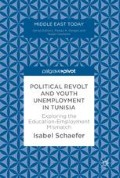Abstract
This chapter looks at current trends on the Tunisian labor market and the challenge of skill mismatch.
Access this chapter
Tax calculation will be finalised at checkout
Purchases are for personal use only
Notes
- 1.
- 2.
BAfD, OCDE, PNUD 2015: African Economic Outlook: Tunisie 2015. Tunis: BAfD, p. 2. http://www.ilo.org/gateway/faces/home/ctryHome?locale=EN&countryCode=TUN®ionId=1&_adf.ctrl-state=a3ho0tkxu_9 (7.7.2015).
- 3.
- 4.
- 5.
- 6.
Pierre, Gaelle (2014): Background Note. Bringing Young People into the Labor Market. Building the Future, p. 1, http://www.imf.org/external/np/seminars/eng/2014/act/pdf/Session3-Youth.pdf (1.10.2015).
- 7.
- 8.
- 9.
http://documents.worldbank.org/curated/en/253011468180259354/pdf/104123-CAS-P151690-Box394874B-OUO-9-R2016-0074.pdf (9.6.2017); BAfD, OCDE, PNUD 2015: African Economic Outlook: Tunisie 2015. Tunis: BAfD, p. 2.
- 10.
- 11.
Le Maghreb, 8.7.2015.
- 12.
For instance, the president of the entrepreneurs ’ association UTICA is a woman: Ouided Bouchamaoui; or Sabiha Derbal became the new PDG of the state-owned train company SNCFT.
- 13.
- 14.
“L’emploi informel est quand à lui défini comme l’emploi sans protection. Plusieurs charactéristiques peuvent être considérées à cet égard pour une définition précise: protection sociale, contrat écrit, feuilles de salaires, indemnités de licenciement, etc. Du fait de ces définitions, l’emploi informel, ainsi que l’emploi non protégé dans le secteur formel. Conformément aux définitions de l’OIT (2003), le secteur et l’emploi informels composent ce qui est désigné sous le terme d’économie informelle” (Cling et al. 2012: 7).
- 15.
ONEQ (2013): Rapport Annuel sur Le marché du travail en Tunisie. Tunis: ONEQ, p. 9.
- 16.
Pierre, Gaelle (2014): Background Note. Bringing Young People into the Labor Market. Building the Future, p.1. http://www.imf.org/external/np/seminars/eng/2014/act/pdf/Session3-Youth.pdf (1.10.2015).
- 17.
Interviews with entrepreneurs and experts, Tunis, 26.8-16.3.2015.
- 18.
Small enterprise means 5–20 employees; medium enterprise means 20–100 employees; large enterprise means more than 100 employees.
- 19.
Underemployed population is a subcategory of employed population, does not appear in official statistics about unemployed persons. http://www.ilo.org/global/statistics-and-databases/statistics-overview-and-topics/under-employment/lang--en/index.htm (21.10.15).
Bibliography
Carneiro, P., C. Crawford, and A. Goodman. 2007. The Impact of Early Cognitive and Non-cognitive Skills on Later Outcomes. Discussion Paper 0092, Centre for the Economics of Education, London School of Economics, London.
Cling, Jean-Pierre et al. (eds.). 2012. L’économie informelle dans les pays en développement. Paris: AfD.
David, Anda, and Christophe J. Nordman. 2014. Skill Mismatch and Migration in Egypt and Tunisia. Paris: Paris Dauphine University.
Handel, Michael J., Alexandria Valerio, and Maria Laura Sanchez Puerta. 2016. Accounting for Mismatch in Low- and Middle-Income Countries. Measurement, Magnitudes, and Explanations. Washington, DC: World Bank.
Heckman, J.J., J. Stixrud, and S. Urzua. 2006. The Effects of Cognitive and Noncognitive Abilities on Labor Market Outcomes and Social Behavior. Paper w12006, National Bureau of Economic Research, Cambridge, MA.
Jouini, Elyès (ed.). 2013. Tunisie L’Espoir. Mode d’emploi pour une reprise. Tunis: Cérès/Idées.
Oschmiansky‚ Frank. 2010. Arthen der ardeiblosigheit. Bonn: Bpo.
Pierre, Gaelle. 2014. Background Note. Bringing Young People into the Labor Market. Building the Future, p. 1. http://www.imf.org/external/np/seminars/eng/2014/act/.
Subrahmanyam, Gita and Vincent Castel. 2014. Labour Market Reforms in Post-Transition North Africa. Economic Brief, AfDB, Tunis.
Weinmann, Christoph David. 2014. Employment and Labor Market Analysis Tunisia. Final Report. Bonn: GIZ.
Documents
INS. 2017. Tunisie en chiffres 2016. Tunis: INS.
OECD. 2015a. http://skills.oecd.org/hotissues/skillsmismatch.html (1.12.2015).
OECD. 2015b. Investing in Youth. Strenthening the Employability of Youth during the Transition to a Green Economy. Paris: OECD.
UNDP. 2016. Arab Human Development Report. Newyork: UNDP.
World Bank. 2014a. Jobs or Privileges: Unleashing the Employment Potential of the Middle East and North Africa, Hania Sahnoun et al. Washington, DC: World Bank.
World Bank. 2014b. Tunisia Development Policy Review. In Mimeo. Washington, DC: World Bank.
World Bank. 2014c. Tunisia. Breaking the Barriers to Youth Inclusion. Washington, DC: World Bank.
World Economic Forum (WEF). 2016. (ed.): Human Capital Report (HCR). Geneva/Newyork: WEF.
Author information
Authors and Affiliations
Corresponding author
Rights and permissions
Copyright information
© 2018 The Author(s)
About this chapter
Cite this chapter
Schaefer, I. (2018). Labor Market Trends. In: Political Revolt and Youth Unemployment in Tunisia. Middle East Today. Palgrave Macmillan, Cham. https://doi.org/10.1007/978-3-319-65085-2_4
Download citation
DOI: https://doi.org/10.1007/978-3-319-65085-2_4
Published:
Publisher Name: Palgrave Macmillan, Cham
Print ISBN: 978-3-319-65084-5
Online ISBN: 978-3-319-65085-2
eBook Packages: Political Science and International StudiesPolitical Science and International Studies (R0)

